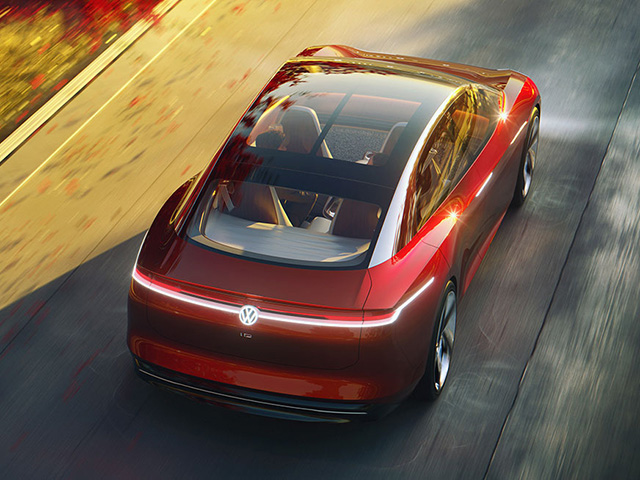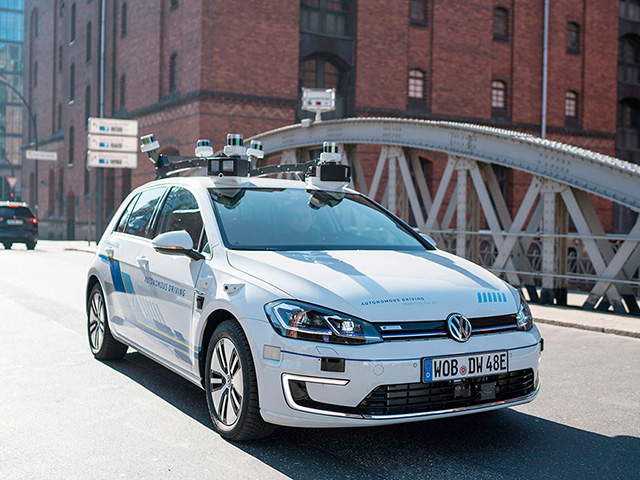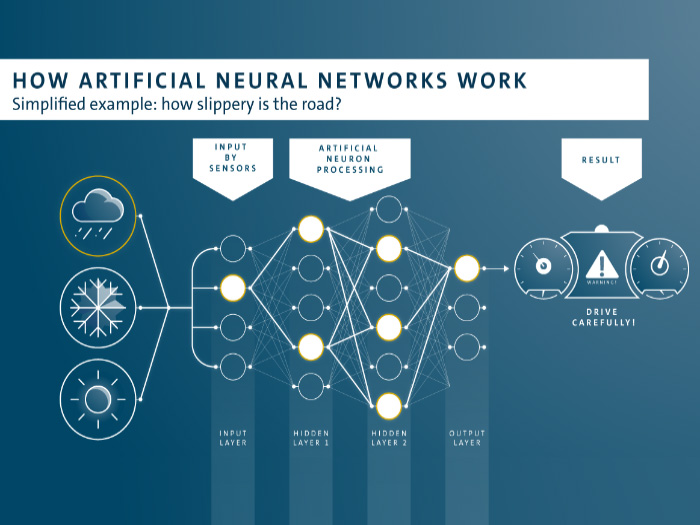Artificial neural networks, the key to autonomous driving
The human brain and its neurons are the model for artificial neuronal networks, a special type of artificial intelligence (AI). These networks can recognize patterns and act independently.
The sky above is full of clouds and a few drops of rain soon becomes a summer storm. A careful driver would slow down, steer, brake and accelerate more smoothly. But how should an autonomous vehicle behave in the same conditions? How should it determine the slipperiness of the road and calculate the complex interaction of all these factors?
“What is simple for a computer is usually difficult for people – and vice versa", says Paul Hochrein, who researches autonomous driving at Volkswagen Group.
Cooperation between Volkswagen Group and Stanford
The artificial intelligence of an autonomous vehicle has to continually recalculate the same process that usually happens unconsciously in the human mind several times per second. It also has to compare the results with internal data records and the input of numerous sensors. At the same time, it must keep an eye on the surrounding environment, follow numerous written and unwritten rules and react to new situations in a fraction of a second. It is a really complex task, which is why the Volkswagen Group is conducting research together with Stanford University in California.
Handling extreme situations

The most complex challenge is making assisted driving, and even more so autonomous driving, suited to all conceivable situations on the road. “We want to prove to the car that this is possible”, says Hochrein, referring to the Pikes Peak race in Colorado, in which the Volkswagen Group has already set various records.
In general, there are two main challenges for AI in autonomous driving: driving at the limit on the racetrack and dealing with city traffic. “If a complete system including AI can handle such extreme situations, you’re already a huge step ahead”, Hochrein adds.
Recognising the scenario

Whether on a racetrack or in a big city, how should an autonomous vehicle deal with changing driving conditions? Volkswagen Group and Stanford University have come up with an answer to this question: an artificial neural network that can recognize different surfaces and react accordingly. And it’s better and more flexible than traditional software that can only perform tasks such as semi-autonomous driving and follow preset schemes, with immense prior programming effort.
Artificial neural networks are a special form of artificial intelligence – and of great importance for the development of autonomous and assisted driving.
Getting ready for the real world
Hochrein explains artificial intelligence as follows: “Mathematical functions that act as a human would”. But there is a problem with autonomous driving. “If we use simple algorithms, they do what they are supposed to do. But they do not represent reality accurately enough for safe autonomous driving”.
After all, enormous amounts of different data have to be processed when driving: from the steering wheel angle to the possible behaviour of an oncoming motorcycle, to the question of whether the traffic lights in front are red or green and whether they are aimed at the driver’s own lane or not. Representing all of this mathematically leads to very complex formulas. This is why something different is needed: a sort of mechanical brain thatoperates in binary but does not have to be programmed down to the last detail. Rather, it should be able to program itself – with human help.
Training AI: how to recognise a dog

Artificial neural networks, like human ones, try to find out which patterns produce the desired results. The network itself selects which neuron is linked to which other neurons and to what extent. In other words: the original programming only provides the rough framework – and AI fills the details independently. The patterns proved to be efficient are retained and reinforced. However, this is only possible if it is “trained” correctly.
An example: a neural network should learn to recognize photos of dogs and not to confuse them with those of cats, for example. It receives different sets of photos of different dogs, as well as of cats, and the corresponding information as to which output is the right one.
The network therefore independently analyses and experiments with the numerous pixels, recognising patterns and distinguishing features, and correlates them. In this way, it will learn which parameters it has to change so that its internal process, from the input of the photo to the output “This is a dog”, is correct.
“The basic idea for artificial neural networks had been around for a long time, but now advances in computer science have combined with advances in computing power”. As far as autonomous driving is concerned, Hochrein is optimistic: “Level 5, i.e. fully automated driving, is basically feasible, but it is a highly complex task to get it safely on the road. Neural networks are not a remedy for everything, but they are enormously important for the development of autonomous and assisted driving”.
Source: Volkswagen AG
